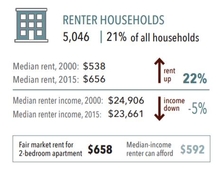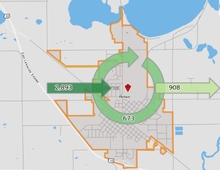Private organization tackles housing
Core housing issues addressed
- Housing stock and affordability
- Housing finance
Housing challenges
Local manufacturing expansions drive the need for workforce housing in Perham, a town of 3,300 in northern Otter Tail County. As a center of food manufacturing (KLN Enterprises) and the headquarters of Arvig Companies (a growing telecommunications company), Perham has long needed new and entry-level workers. After many years of unmet demand, a private development group named Grow Perham formed to develop workforce housing as part of its workforce development and attraction formula.
Community profile
A large portion of Perham’s housing is rental—39 percent, according to the 2017 American Community Survey. In Otter Tail County, Perham is clearly a standout community in this regard. Only 21 percent of all housing units in Otter Tail County are rental, so Perham has nearly twice the proportion.
rent and income adjusted for inflation (Source: MHP)
The small proportion of rentals in the county (21 percent compared to 29 percent in Minnesota) may contribute to rising rents where demand is strong, especially in Perham. According to the Minnesota Housing Partnership (MHP), rents increased 22 percent in Otter Tail County from 2000 to 2015, while renter income decreased during the same time period (Figure 2). Furthermore, their analysis of the county’s housing cost burden shows a large majority of renter households making less than $35,000 annually pay more than 30 percent of their income toward housing costs (see MPH, Housing Profile under sources).
Many workers commute to Perham. According to On the Map data from the U.S. Census Bureau, which tracks locations of workers’ residences and places of employment, nearly 2,900 people who live outside the community travel to Perham for work (Figure 3). This statistic underscores the strength of the local employment base in a community of 3,300.
Evidence from the Census Bureau and other sources points to a clear need for housing development in the community and reinforces employers’ concerns that housing is a long-term issue affecting worker recruitment.
Housing success story
As of 2017, Grow Perham has built nine multi-family housing developments and acquired two other rental properties for a total of 180 market-rate housing units. Construction is also underway for a 24-unit building. On average, each unit cost $72,407 to build. These properties house more than 220 individuals and have nearly 100 percent occupancy. Other organizations have also developed residential lots and single-family homes in the community to address the growing issue of workforce housing. It is possible Grow Perham’s initiative to build multi-family homes has encouraged investment in these other types of housing.
Project partnership
Formed in 2007, Grow Perham now has 23 individual investors. Many helped fund the organization and leveraged other financing to make the vision of providing more workforce housing a reality. Organized by a trusted peer, one meeting included up to 15 fellow businesses and individuals who pledged funds supporting the endeavor. According to Chuck Johnson, Perham’s economic development director, the organization grew out of a business need but is sustained by a commitment to community. Johnson says the commitment to build a better Perham is the group’s primary motivation, noting investors have chosen to forego more lucrative investments elsewhere. In Perham, housing helps retain workers locally and provides a place to call home for these employees and their families.
Programs and financial resources
Grow Perham has leveraged equity from private investments to make new developments and improvements, including:
- Approximately $3 million in private capital raised since its inception to cover more than $13 million in construction costs.
- A $620,000 grant through the Department of Employment and Economic Development (DEED) Workforce Housing Development Program in 2016 that supported construction costs.
- Tax Increment Financing (TIF), as approved by the City of Perham, as well as tax abatement approved by the City of Perham, Otter Tail County, and the Perham School District that has assisted in financing projects. As a testament to their success and ability to cash flow housing projects, the group’s most recent new development is moving forward without any public assistance.
Who can you follow up with to learn more or to clarify housing project details?
Chuck Johnson, economic development director
Phone: 218-346-9798 | Email Address: cjohnson@cityofperham.com
- Personal interview with Chuck Johnson, 2017.
- Minnesota Demographic Center, County Population Projections, 2017. Retrieved from Census Bureau, On the Map, 2017.
- Minnesota Housing Partnership, Housing Profiles, 2017.
- Greater Minnesota Housing Fund, “Perham Business Leaders Tackle Local Housing Issue Themselves,” Nov. 2017.
- Grow Perham presentation from David Schornack
About the MN Rural Housing study
Small rural communities in Minnesota face persistent housing challenges. In 2017, the state’s regional development organizations (RDOs) identified housing as a top learning focus and called for the creation of case studies that highlight creative solutions to persistent housing issues in smaller communities. This project is a collaboration between the University of Minnesota Extension Department of Community Development and the Center for Small Towns. It is jointly funded by the federally-funded Economic Development Administration (EDA) Center at University of Minnesota at Crookston and University of Minnesota’s Extension Department of Community Development.
Reviewed in 2018





